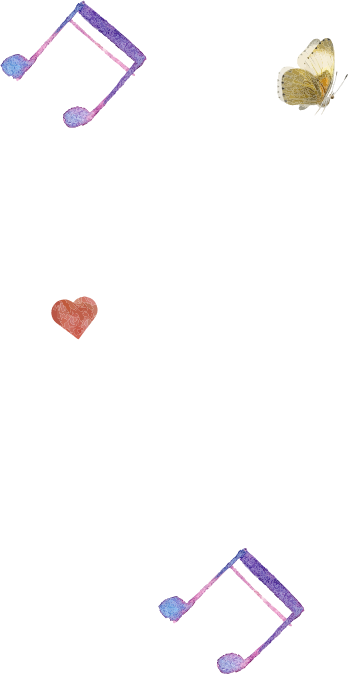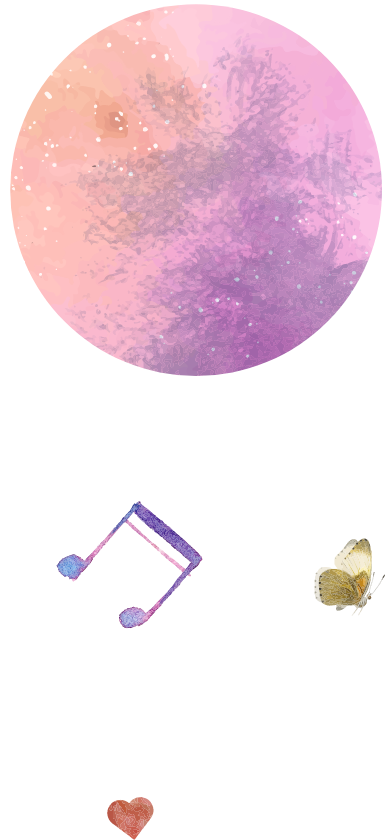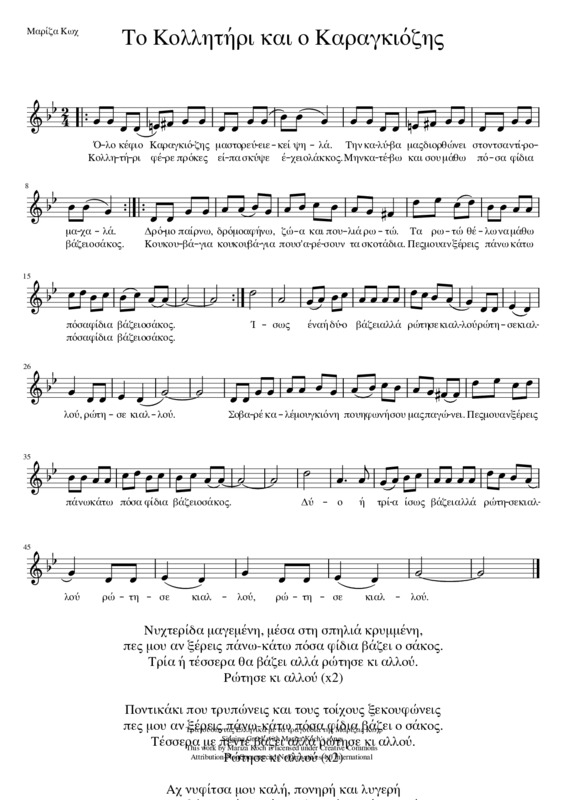
To kollētēri kai o Karankiozēs

To kollētēri kai o Karankiozēs
Pronunciation
Practice the rhythmic and melodic recitation of the text as a speech and as a song.
Speech Comprehension and Production
Make reference to the expression "πόσα φίδια βάζει ο σάκος" (posa phidia vazei o sakos) which is a variation of the phrase "πόσα απίδια βάζει ο σάκος" (posa apidia vazei o sakos, used in order to threaten someone with a punishment, usually including physical abuse) a common phenomenon in shadow theater i.e. σε συγχαίρω - κι εγώ σε συχαίνομαι (se sygxairō - ki egō se syxainomai, I congratulate you - I hate you too), ορεβουάρ - αλλεβρουάρ (au revoir - allevrouar), etc.
Use of climax in the structure of the speech with the appearance of a different animal for each number. Written down in order: κουκουβάγια (koukouvagia, owl), γκιώνης (gkiōnēs, Eurasian scops owl), νυχτερίδα (nychterida, bat), ποντικάκι (pontikaki, mouse), νυφίτσα (nyphitsa, weasel), γάτα (gata, cat), δεκαοχτούρα (dekaochtoura, Eurasian collared dove), χελωνίτσα (chelōnitsa, tortoise), σαύρα (saura, lizard).
Note that animals mentioned are nocturnal or associated with something dark and dramatic in oral tradition.
Discuss the characters of the story and how they are portrayed: Karankiozēs tinkers, repairs the rickety barrack, Kollētērēs avoids his share of the work, assigns it to others, gets no answer and returns disappointed to his father and works by his side.
Produce spoken or written dialogues related to the story. Write new verses in question format ending with the same phrase "ρώτησε κι αλλού" (rōtēse ki allou), with a selection of other animals and make reference to their characteristics.
Use of climax in the structure of the speech with the appearance of a different animal for each number. Written down in order: κουκουβάγια (koukouvagia, owl), γκιώνης (gkiōnēs, Eurasian scops owl), νυχτερίδα (nychterida, bat), ποντικάκι (pontikaki, mouse), νυφίτσα (nyphitsa, weasel), γάτα (gata, cat), δεκαοχτούρα (dekaochtoura, Eurasian collared dove), χελωνίτσα (chelōnitsa, tortoise), σαύρα (saura, lizard).
Note that animals mentioned are nocturnal or associated with something dark and dramatic in oral tradition.
Discuss the characters of the story and how they are portrayed: Karankiozēs tinkers, repairs the rickety barrack, Kollētērēs avoids his share of the work, assigns it to others, gets no answer and returns disappointed to his father and works by his side.
Produce spoken or written dialogues related to the story. Write new verses in question format ending with the same phrase "ρώτησε κι αλλού" (rōtēse ki allou), with a selection of other animals and make reference to their characteristics.
Music Activities
Sing with emphasis on the fast and non melismatic articulation.
With the exception of the first verse that has a different melody, all the other verses have a strophic form. The first part, in which Kollētērēs asks questions, is the most rhythmic section of the song (syllabic, it refers to walking), while the second part of the phrase, in which the animal responds, is more melodic (slow, it refers to indifference, contradictory answer).
Divide the class into two groups, one group sings and walks when Kollētērēs speaks and the other group does the same when the animals speak (each child takes the role of one animal, answers alone in the 3rd verse i.e. "μάλλον πέντε με έξι βάζει, αλλά ρώτησε κι αλλού" (mallon pente me exi vazei, alla rōtēse ki allou) and its group continues the phrase "ρώτησε κι αλλού" (rōtēse ki allou) while dancing.
Dramatize the song.
Sound experimentation (musical instruments and sound sources) aiming to the creation of acoustic patterns that are characteristic and identifying of each animal.
Augmented and diminished fourth intervals (La-Re).
Make reference to climactic songs of the Greek tradition that resemble to the climax of the song, such as: "Να το πούμε ένα" [Ένα είναι το αηδόνι] (Na to poume ena [Ena einai to aēdoni]), "Ντήλι-ντήλι το καντήλι" (Ntēli-ntēli to kantēli), "Από το άλφα θε να αρχίσω" (Apo to alpha the na archisō), etc.
With the exception of the first verse that has a different melody, all the other verses have a strophic form. The first part, in which Kollētērēs asks questions, is the most rhythmic section of the song (syllabic, it refers to walking), while the second part of the phrase, in which the animal responds, is more melodic (slow, it refers to indifference, contradictory answer).
Divide the class into two groups, one group sings and walks when Kollētērēs speaks and the other group does the same when the animals speak (each child takes the role of one animal, answers alone in the 3rd verse i.e. "μάλλον πέντε με έξι βάζει, αλλά ρώτησε κι αλλού" (mallon pente me exi vazei, alla rōtēse ki allou) and its group continues the phrase "ρώτησε κι αλλού" (rōtēse ki allou) while dancing.
Dramatize the song.
Sound experimentation (musical instruments and sound sources) aiming to the creation of acoustic patterns that are characteristic and identifying of each animal.
Augmented and diminished fourth intervals (La-Re).
Make reference to climactic songs of the Greek tradition that resemble to the climax of the song, such as: "Να το πούμε ένα" [Ένα είναι το αηδόνι] (Na to poume ena [Ena einai to aēdoni]), "Ντήλι-ντήλι το καντήλι" (Ntēli-ntēli to kantēli), "Από το άλφα θε να αρχίσω" (Apo to alpha the na archisō), etc.
Cross-thematic Connections - Greek Culture
Interdisciplinary concept: variation.
On the occasion of the element of variation in the lyrics of the song, the pupils search for objects of everyday life and artwork structurally characterized by the technique of variation (Andy Warhol's works, embroideries, carpets, variations of Wolfgang Amadeus Mozart's "Ah vous dirai-je, Maman", variations in cinematographic films with the same pattern, variations in Greek folk songs, in fashion, in commercials).
Make reference to Karankiozēs' character, as portrayed in the Greek shadow theater: a handyman who casually does whatever job he comes across, does sloppy work, he always tries to earn more money himself when splitting the profits, embodies the element of the ephemeral, and constantly confirms the contradiction "θα φάμε, θα πιούμε και νηστικοί θα κοιμηθούμε" (tha fame, tha pioume kai nēstikoi tha koimēthoume - we will eat, we will drink and we will go to sleep with an empty stomach). Karankiozēs' symbolic parallelism with the Greeks of today.
On the occasion of the element of variation in the lyrics of the song, the pupils search for objects of everyday life and artwork structurally characterized by the technique of variation (Andy Warhol's works, embroideries, carpets, variations of Wolfgang Amadeus Mozart's "Ah vous dirai-je, Maman", variations in cinematographic films with the same pattern, variations in Greek folk songs, in fashion, in commercials).
Make reference to Karankiozēs' character, as portrayed in the Greek shadow theater: a handyman who casually does whatever job he comes across, does sloppy work, he always tries to earn more money himself when splitting the profits, embodies the element of the ephemeral, and constantly confirms the contradiction "θα φάμε, θα πιούμε και νηστικοί θα κοιμηθούμε" (tha fame, tha pioume kai nēstikoi tha koimēthoume - we will eat, we will drink and we will go to sleep with an empty stomach). Karankiozēs' symbolic parallelism with the Greeks of today.
Age level
7-11 years old
Language level
Intermediate
Advanced
Ta tragoudia pane theatro




